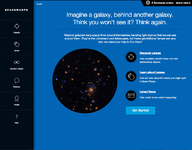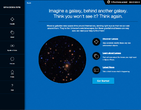Space Warps: Difference between revisions
No edit summary |
Himmelattack (talk | contribs) No edit summary |
||
| Line 21: | Line 21: | ||
|field_contact_person_URLs=http://talk.spacewarps.org/ | |field_contact_person_URLs=http://talk.spacewarps.org/ | ||
|field_team_location=University of Oxford | |field_team_location=University of Oxford | ||
|field_participant_task_description=Mark gravitational lenses | |||
|field_volonteer_computing=no | |field_volonteer_computing=no | ||
|field_volonteer_thinking=no | |field_volonteer_thinking=no | ||
|field_volonteer_sensing=no | |field_volonteer_sensing=no | ||
|field_volonteer_gaming=no | |field_volonteer_gaming=no | ||
|field_tutorials_documentation= | |field_data_types_to_manipulate=pictures | ||
|field_participant_contribution_type=data analysis, data interpretation | |||
|field_interaction_with_objects=Mark gravitational lenses on photos. | |||
|field_interface_attractivity=cool/attractive | |||
|field_interface_usability=easy to use | |||
|field_tutorials_documentation=yes | |||
|field_peer_to_peer_guidance=N/A | |field_peer_to_peer_guidance=N/A | ||
|field_training_sequence= | |field_training_sequence=weak | ||
|field_individual_performance_feedback= | |field_individual_performance_feedback=yes | ||
|field_collective_performance_feedback=N/A | |field_collective_performance_feedback=N/A | ||
|field_research_progress_feedback=N/A | |field_research_progress_feedback=N/A | ||
|field_member_profiles= | |field_member_profiles=minimal | ||
|field_community_tools=website, blog, forum | |||
|field_has_community_manager=N/A | |field_has_community_manager=N/A | ||
|field_project_news_updates=N/A | |field_project_news_updates=N/A | ||
Latest revision as of 12:50, 15 November 2013
Cs Portal > List of citizen science projects > Space Warps - (2013/11/14)
IDENTIFICATION
- Beta start date : N/A
- End date : Still open.
- Natural sciences > astronomy, astrophysics (space)
- Others in the same subject areas: Air Quality with Biomarkers, Andromeda Project, Bat detective, Budburst... further results
- Others projects about space: Andromeda Project, Galaxy Zoo, Solar Stormwatch, The Milky Way Project
⇳ Description Massive galaxies warp space-time around themselves, bending light rays so that we can see around them. They're the Universe's own telescopes, but these gravitational lenses are very rare: we need your help to find them! ➠ Purpose Human beings have a remarkable ability to recognise patterns and detect the unusual with only minimal training. With a basic understanding of what the distorted images of galaxies that have passed through a gravitational lens look like, participants in the SpaceWarps project can help discover new examples of this amazing phenomenon, and enable our survey scientists to carry out new investigations of stars and dark matter in the universe. We will be doing two types of lens search. In our blind searches, we’ll be asking volunteers to spot signs of gravitational lensing in images of the sky taken as part of the CFHT (Canada-France-Hawaii Telescope) legacy survey. This survey has been searched by computers, but we’re pretty sure they didn’t catch all the lenses to be found! These results will help us re-train the computers to do better on larger surveys in future. Then, in our targeted searches, in other upcoming sky surveys, we’ll be showing participants galaxies and groups of galaxies that our computers have selected as possibly being gravitational lenses. The task will then be to assess whether or not they actually are! In both cases, there will be confusing objects around - the challenge is to come up with the most plausible explanation for what is going on, in collaboration with the rest of the SpaceWarps community. Do you think you can spot outer space being warped? We do! ? Research question Einstein's theory of gravity, General Relativity, made a remarkable prediction. Massive objects, such as stars, would bend the space around them such that passing light rays follow curved paths. Evidence for this revolutionary theory was first obtained by Arthur Eddington in 1919, when during a solar eclipse he observed that stars near the edge of the Sun appeared to be slightly out of position. The Sun was behaving like the lens in a magnifying glass and bending the light from the background stars!
In 1937, Fritz Zwicky realized that massive galaxies (which can contain anywhere from ten million to a hundred trillion stars) or clusters of galaxies could be used to magnify distant galaxies that conventional telescopes couldn’t detect. As you can see, not unlike a conventional magnifying glass, these gravitational lenses not only magnify and focus the light of the distant background galaxies but they can, and mostly do, distort them as well.
When one of these gravitational lenses happens to sit right in front of a background galaxy, the magnification factor can be up to x10 or even more, giving us a zoomed-in view of the distant universe, just at that particular point. Lenses can help us investigate young galaxies more than halfway across the universe, as they formed stars and started to take on the familiar shapes we see nearby.
Observations of the distorted background galaxy can also give us useful information about the object that is behaving as a gravitational lens. The separation and distortion of the lensed images can tell astronomers how much mass there is in the object, and how it is arranged. It’s one of the few ways we have of mapping out where the dark matter in the universe is, how clumpy it is and how dense it is near the centers of galaxies. Knowing this can provide crucial information about how galaxies evolve.
TEAM
University of Oxford
Project team page http://spacewarps.org/#/about Leader: Phil Marshall Institution: University of Oxford Physics Partner institutions: Contact: http://talk.spacewarps.org/
USER TASKS
CONTRIBUTION TYPE: data analysis, data interpretation
PARTICIPATION TYPOLOGY:
GAMING GENRE NONE
GAMING ELEMENTS: NONE
◉ Tasks description Mark gravitational lenses ⤯ Interaction with objects Mark gravitational lenses on photos. ▣ Interface
- Data type to manipulate: pictures
- interface enjoyment: cool/attractive
- Interface usability: easy to use
GUIDANCE
- Tutorial: ✓
- Peer to peer guidance: Somewhat
- Training sequence: Somewhat
- Individual performance: ✓
- Collective performance: Somewhat
- Research progress: Somewhat
❂ Feedback and guidance description
COMMUNITY
- Main news site:
- Frequency of project news updates: N/A
- Type of events:
- Frequency of events :
⏣ Community description
- Community size (volounteers based)
- Role:
- Interaction form:
- Has official community manager(s): N/A
- Has team work N/A
- Other:
- Community led additions:
Other information
PROJECT
Url:http://spacewarps.org/
Start date:
End date: Still open
TEAM
Official team page:http://spacewarps.org/#/about
Leader: Phil Marshall
Institution: University of Oxford Physics
Contact: http://talk.spacewarps.org/
Main location: University of Oxford
PROJECT DEFINITION
Subject
Natural sciences > astronomy, astrophysics (space)
Description
Massive galaxies warp space-time around themselves, bending light rays so that we can see around them. They're the Universe's own telescopes, but these gravitational lenses are very rare: we need your help to find them!
Purpose.
Human beings have a remarkable ability to recognise patterns and detect the unusual with only minimal training. With a basic understanding of what the distorted images of galaxies that have passed through a gravitational lens look like, participants in the SpaceWarps project can help discover new examples of this amazing phenomenon, and enable our survey scientists to carry out new investigations of stars and dark matter in the universe. We will be doing two types of lens search. In our blind searches, we’ll be asking volunteers to spot signs of gravitational lensing in images of the sky taken as part of the CFHT (Canada-France-Hawaii Telescope) legacy survey. This survey has been searched by computers, but we’re pretty sure they didn’t catch all the lenses to be found! These results will help us re-train the computers to do better on larger surveys in future. Then, in our targeted searches, in other upcoming sky surveys, we’ll be showing participants galaxies and groups of galaxies that our computers have selected as possibly being gravitational lenses. The task will then be to assess whether or not they actually are! In both cases, there will be confusing objects around - the challenge is to come up with the most plausible explanation for what is going on, in collaboration with the rest of the SpaceWarps community. Do you think you can spot outer space being warped? We do!
Research question.
Einstein's theory of gravity, General Relativity, made a remarkable prediction. Massive objects, such as stars, would bend the space around them such that passing light rays follow curved paths. Evidence for this revolutionary theory was first obtained by Arthur Eddington in 1919, when during a solar eclipse he observed that stars near the edge of the Sun appeared to be slightly out of position. The Sun was behaving like the lens in a magnifying glass and bending the light from the background stars! In 1937, Fritz Zwicky realized that massive galaxies (which can contain anywhere from ten million to a hundred trillion stars) or clusters of galaxies could be used to magnify distant galaxies that conventional telescopes couldn’t detect. As you can see, not unlike a conventional magnifying glass, these gravitational lenses not only magnify and focus the light of the distant background galaxies but they can, and mostly do, distort them as well. When one of these gravitational lenses happens to sit right in front of a background galaxy, the magnification factor can be up to x10 or even more, giving us a zoomed-in view of the distant universe, just at that particular point. Lenses can help us investigate young galaxies more than halfway across the universe, as they formed stars and started to take on the familiar shapes we see nearby. Observations of the distorted background galaxy can also give us useful information about the object that is behaving as a gravitational lens. The separation and distortion of the lensed images can tell astronomers how much mass there is in the object, and how it is arranged. It’s one of the few ways we have of mapping out where the dark matter in the universe is, how clumpy it is and how dense it is near the centers of galaxies. Knowing this can provide crucial information about how galaxies evolve.
ABOUT PARTICIPANT TASKS
Tasks description.
Mark gravitational lenses
Interaction with system objects.
Mark gravitational lenses on photos.
| Grey typology | Participation typology | Contribution type: | ||||||||||||||||||||||||||||
|---|---|---|---|---|---|---|---|---|---|---|---|---|---|---|---|---|---|---|---|---|---|---|---|---|---|---|---|---|---|---|
|
|
|
||||||||||||||||||||||||||||
| Gaming | ||||||||||||||||||||||||||||||
| Genre: | Gaming elements: | |||||||||||||||||||||||||||||
| Interface | ||||||||||||||||||||||||||||||
| Data type to manipulate: pictures | interface enjoyment: cool/attractive Interface usability: easy to use |
Member profiles::minimal Member profile elements: |
||||||||||||||||||||||||||||
ABOUT GUIDANCE AND FEEDBACK
| Guidance | Feedback on | ||||||||||||
|---|---|---|---|---|---|---|---|---|---|---|---|---|---|
|
|
.
COMMUNITY
| Tools | News & Events |
|---|---|
|
Communication: website, blog, forum |
Main news site: |
| Community description | |
|
Community size (volounteers based): |
|
Other information about community:
Community led additions:
OTHER PROJECT INFORMATION
Capture d’écran 2013-11-14 à 15.03.54.png Yes [[has completion level::Low]
University of Oxford http://talk.spacewarps.org/
Yes astronomy, astrophysics Natural sciences space Human beings have a remarkable ability to recognise patterns and detect the unusual with only minimal training. With a basic understanding of what the distorted images of galaxies that have passed through a gravitational lens look like, participants in the SpaceWarps project can help discover new examples of this amazing phenomenon, and enable our survey scientists to carry out new investigations of stars and dark matter in the universe. We will be doing two types of lens search. In our blind searches, we’ll be asking volunteers to spot signs of gravitational lensing in images of the sky taken as part of the CFHT (Canada-France-Hawaii Telescope) legacy survey. This survey has been searched by computers, but we’re pretty sure they didn’t catch all the lenses to be found! These results will help us re-train the computers to do better on larger surveys in future. Then, in our targeted searches, in other upcoming sky surveys, we’ll be showing participants galaxies and groups of galaxies that our computers have selected as possibly being gravitational lenses. The task will then be to assess whether or not they actually are! In both cases, there will be confusing objects around - the challenge is to come up with the most plausible explanation for what is going on, in collaboration with the rest of the SpaceWarps community. Do you think you can spot outer space being warped? We do! Einstein's theory of gravity, General Relativity, made a remarkable prediction. Massive objects, such as stars, would bend the space around them such that passing light rays follow curved paths. Evidence for this revolutionary theory was first obtained by Arthur Eddington in 1919, when during a solar eclipse he observed that stars near the edge of the Sun appeared to be slightly out of position. The Sun was behaving like the lens in a magnifying glass and bending the light from the background stars!
In 1937, Fritz Zwicky realized that massive galaxies (which can contain anywhere from ten million to a hundred trillion stars) or clusters of galaxies could be used to magnify distant galaxies that conventional telescopes couldn’t detect. As you can see, not unlike a conventional magnifying glass, these gravitational lenses not only magnify and focus the light of the distant background galaxies but they can, and mostly do, distort them as well.
When one of these gravitational lenses happens to sit right in front of a background galaxy, the magnification factor can be up to x10 or even more, giving us a zoomed-in view of the distant universe, just at that particular point. Lenses can help us investigate young galaxies more than halfway across the universe, as they formed stars and started to take on the familiar shapes we see nearby.
Observations of the distorted background galaxy can also give us useful information about the object that is behaving as a gravitational lens. The separation and distortion of the lensed images can tell astronomers how much mass there is in the object, and how it is arranged. It’s one of the few ways we have of mapping out where the dark matter in the universe is, how clumpy it is and how dense it is near the centers of galaxies. Knowing this can provide crucial information about how galaxies evolve.
Space Warps Mark gravitational lenses data analysis, data interpretation
pictures, other:
Thinking: no
Computing: no
Sensing: no
Gaming: no
Mark gravitational lenses on photos.
cool/attractive
easy to use
yes
N/A
weak
yes
N/A
N/A
minimal
N/A
N/A
Low
Bibliography
| BIBLIOGRAPHY |



